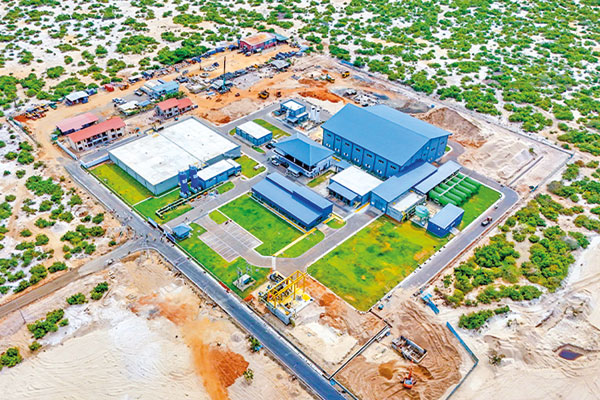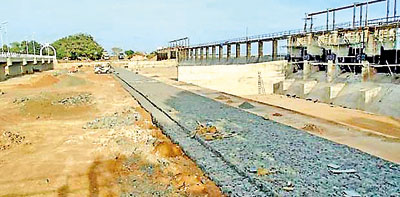News
Jaffna drinking water plant to benefit hundreds of thousands
View(s):By Kevin De Alwis
The long-awaited Thalaiyadi Sea Water Desalination Plant was commissioned on August 2.
Situated on the flat plains of Jaffna, the Jaffna and Kilinochchi water supply project, was launched in 2011, with a loan from the Asian Development Bank and the French Development Bank, the co-financier. It is expected to ease the severe drinking water shortage. Relying on groundwater has been fraught with challenges.

A model of Thalaiyadi Sea Water Desalination plant and inset work in progress of the plant
Under a right to information request, NWSDB said that small-scale drinking water projects have been initiated since the 1950s, and today there are 29 projects that provide limited access to water by serving about 3.2% of the population for one hour every day.
The plant is important for Jaffna and Kilinochchi where the area is historically plagued by water scarcity, the NWSDB said.
Economic development by ensuring a stable water supply for local industries and economic activities is one main expected outcome, the NWSDB said. Environmental sustainability is another expected outcome through the use of advanced desalination technology.
NWSDB said that before this project, only 5% of the population had access to piped drinking water, far below the national average of 48%. It is expected to stabilise the region’s water supply, particularly during droughts.
According to NWSDB, the project includes a 24,000 cubic meters per day capacity seawater desalination plant, 20 elevated water towers, 195 kilometre of transmission pipelines, 700km of distribution pipelines, and mechanical and electrical works, all integrated with a supervisory control and data acquisition (SCADA) system for management. 
NWSDB said the project will strengthen the Jaffna Peninsula water resources management through the improvement of existing water ponds to improve groundwater recharge, and a solar-powered lift irrigation system. The headworks of the Iranamadu reservoir are strengthened and improved through the tank augmentation component, which was completed in 2017.
The main issues that NWSDB has identified are concerns about sharing water between different parts of the community. Plans to use water from the Iranamadu Tank led to resistance from farmers. Then, there were technical and environmental challenges, including environmental compliance, and also managing social impacts, particularly on the local fishery activity.
Kamal Dahanayake, the senior project officer (urban and water supply-sanitation), of the Asian Development Bank, Sri Lanka Resident Mission said the project is in an area where most of the infrastructure had been destroyed during the 30-year-long civil conflict. Safe drinking water is essential to improve health and education services and sustain industrial and tourism development in the area.
He said the project will demonstrate the applicability and appropriateness of this technology in Sri Lanka.
The project is a significant infrastructure initiative to help tackle the severe water shortage in the Jaffna Peninsula. This project is collaterally funded by the ADB and the Government of Sri Lanka, where both parties combined for a total investment of US$266 million (Rs 79.4 billion), of which US$210m was a loan from the ADB and the government commits US$56m (Rs 16.7b).
Mr. Dahanayake said this project includes rehabilitation and augmentation of the capacity of the Iranamadu Tank, building of overhead water tanks, extensive pipeline networks, and advanced water management systems like SCADA. The core of the project is the desalination plant, which has capacity to produce 24 million litres of potable water daily, to provide water to 300,000 residents in the Jaffna Peninsula.
Also, 55,000 farmers in the Kilinochchi district will be able to get water from Iranamadu irrigation system improvements.
One big challenge is the high energy consumption. An in-built energy recovery process has been installed.
While the plant disposes concentrated brine into the sea, Mr. Dahanayake said the project got the support of fishing communities to ensure a minimum impact on the environment and fishery activities remain sustainable.
Timeline
1. Initial feasibility studies began in 2005/2006.
2. Project adjustments and stakeholder consultations held from 2007-2014.
3. The desalination option was approved in 2017.
4. Plant handed over in August 2024.
(Source: NWSDB)
| Multi-billion rupee tab to make water from sea Jaffna’s salt water reverse osmosis plant will cost Rs 3.69 billion to operate and maintain, based on the contract, the national auditor noted in a report in 2022 and raised concerns about it being sustainable. The auditor did not say if the cost is annual or otherwise. The plant, in Thalaiyadi village, Vadamarachchi East Divisional Secretariat Division, Jaffna District, is to provide drinking water to about 300,000 people of Jaffna and Palai in Kilinochchi. The Auditor General reported that the loan period ends on 30 June 2026, and that under the existing conditions, the operation and maintenance costs can be covered only for three years within that loan period. Such a large cost will have to be incurred for the period not covered by the loan agreement. There is a risk of sustainability of operation of the unit, the auditor said. The Ministry of Water Supply and Estate Infrastructure Development carries out the project and National Water Supply and Drainage Board, Provincial Irrigation Department of Northern Province and local authorities in the North implement it. | |
The best way to say that you found the home of your dreams is by finding it on Hitad.lk. We have listings for apartments for sale or rent in Sri Lanka, no matter what locale you're looking for! Whether you live in Colombo, Galle, Kandy, Matara, Jaffna and more - we've got them all!

